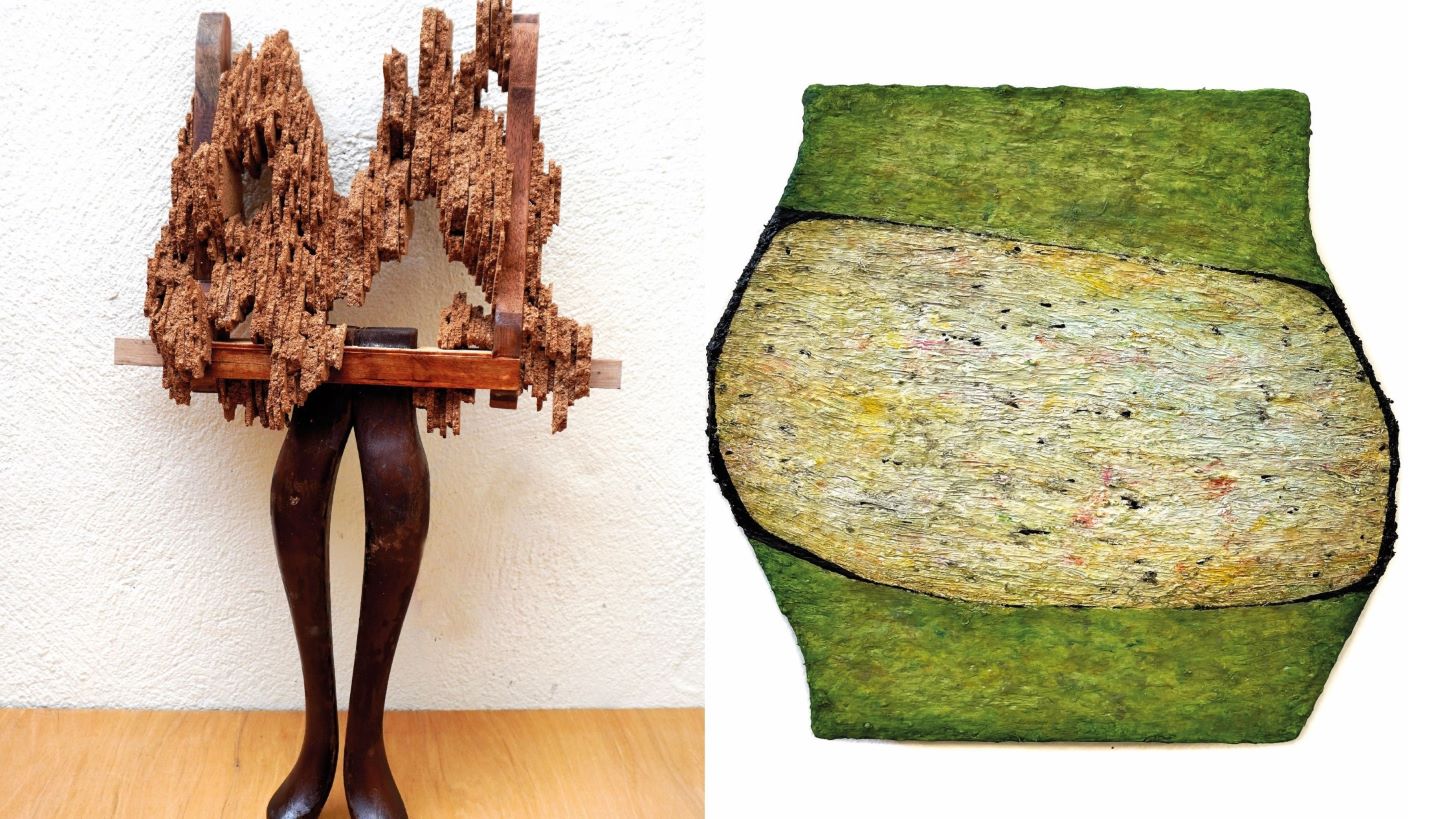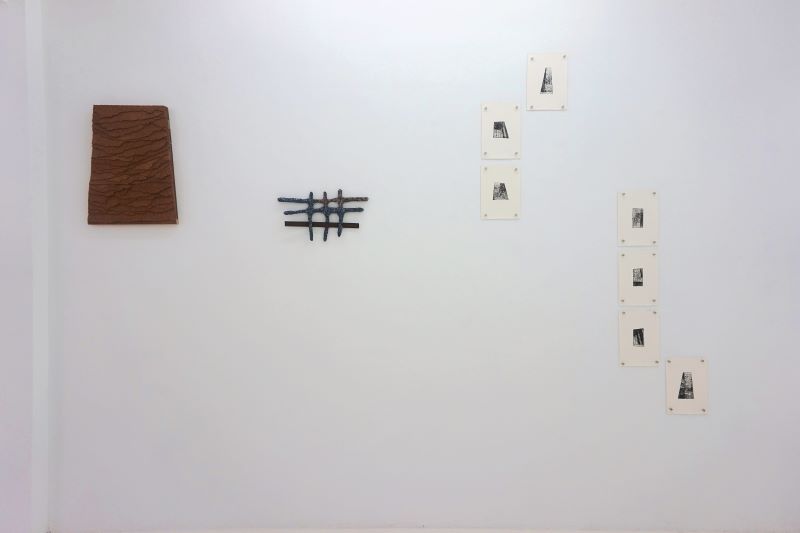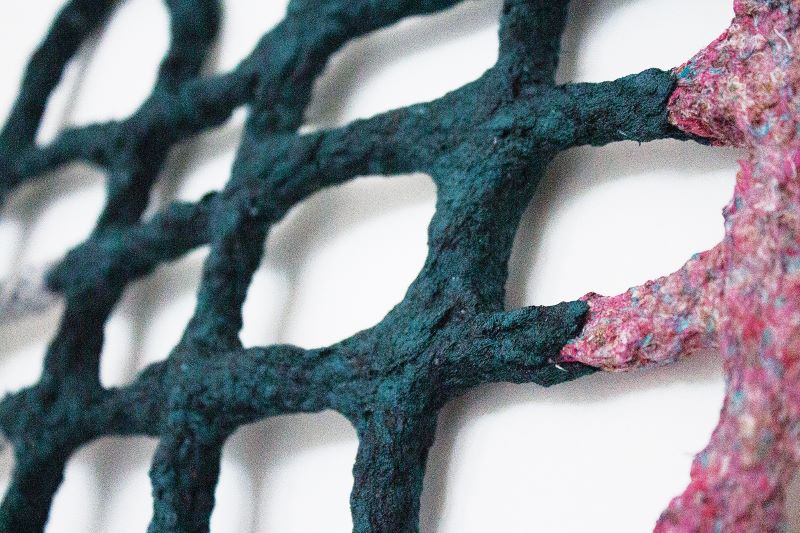
Left: Lee’s Let Me Be Your Dreamer represents how the artist creatively manipulates the materials to form imaginative human body shapes, which interact dynamically with the space within The Back Room; In Surroundings, Giroletti navigates the realms of cosmic and molecular while exploring the interplay of micro processes and macro ideas, using as bridges to larger concepts (All photos: The Back Room KL)
Spanning an array of media, including sculptures, reliefs, drawings, paintings and prints, The Back Room’s latest exhibition Folded Lines delves into the nuanced interplay between personal narratives and universal experiences within urban landscapes, man-made structures and architectural realms. It delightfully intertwines the works of UK-based artists Laura Porter and Gabriela Giroletti with those by Malaysians Lee Mok Yee and Mark Tan, who live in Kuala Lumpur.
Each artist embarks on a journey of creation driven by process, delicately folding and shaping materials to evoke a dynamic dialogue between form and space. Through their artistry, they invite viewers to traverse the liminal spaces where vitality collides with the static, and the organic merges with the inanimate, eliciting a profound sense of exploration and contemplation.
“All the artists in Folded Lines are process-based [and] were interested in the idea of a simple gesture that could be repeated again and again — something that transforms shape, space and form. We felt that visual and physical connotations of folded lines signify the idea of making a 2D object into 3D, and vice versa, but [they] also suggest the coming together of different ideas, materials, cultures and processes,” says Liza Ho, founder of the The Back Room.
Lines are one of the fundamental principles of visual art, and that translates across drawing, printmaking, sculpture and painting, all of which are present in the show. Stemming from a virtual residency project and collaboration between Lee and Porter — and funded by the British Council’s “Connections through Culture” grant programme in 2021 — the show embodies the culmination of their creative exchange. The thematic threads woven throughout the exhibition emerge from extensive dialogues and the exchange of ideas among the two artists.
All four were inspired by their environments, from man-made structures to the natural landscape. “As artists residing in cities, the urban spaces in which they exist offer visual clues and contribute to how they navigate space and form in their works. KL-ite Tan’s work features, inadvertently, imagery he has collected over a long period of time as he traverses the city in which he was born and raised, addressing memory and personal association, while also exploring more universally recognisable shape and form.
three_artwork_including_mark_tans_rigid_folds.jpg

“Both Porter and Lee use artificial materials synonymous with the everyday — cork wood as an accessible material used in mass-production, and clothing that represents the bodies that move through spaces, often temporarily. Giroletti’s small paintings constantly attempt to push back against the constraints of the formal, geometric spaces which we inhabit, returning to something that feels fleshy and organic.”
Ho says much of the work references the spaces in which we move around, and therefore the simultaneous absence and presence of the body are brought into focus. Porter’s pieces, characterised by linear grids formed from clothing, evoke organic growth and transformation. Tan’s work, through imprints, captures memories of place while bridging past moments with the present.
Similarly, Giroletti and Lee integrate organic forms with familiar man-made structures, as seen in the latter’s sculptures featuring deconstructed chairs. This juxtaposition reflects on how bodies navigate spaces, punctuated by moments of pause and reflection. Throughout the exhibition, there is a dynamic interplay between energy and tranquillity, inviting viewers to engage closely with each artwork.
In many ways, all the artists adopt traditional methods but tweak them slightly to generate new outcomes and ideas. “For instance, Porter’s approach aligns with craftsmanship and it involves slow, repetitive and precise work with fabric,” says Ho. “Instead of stitching or knitting these materials together, however, she deconstructs them by cutting them into microscopic fibres. These fibres then serve as raw material from which she creates a new, clay-like substance. The artists’ hands are consistently evident in all four practices, pushing back against more efficient, simplified production methods.”
laura_porter_weave_i_study_detail.jpg

The works in the exhibition are designed to spark curiosity and invite questions. They show familiarity with their subject matter and material, but have elements of the unknown, the absent and the obscure. Ho says presenting smaller works from each artist encourages the viewer to have intimate moments by experiencing them up close. For this, The Back Room is the perfect setting, and there is a narrative quality to the curation of the works in the space that is emphasised by the intimacy of the gallery.
How does this exhibition differ from others held at the same venue? “First, it marks the inaugural showcase of UK-based artists at our venue, and we extend our gratitude to them for choosing our space to bridge this gap. We also extend our thanks to the supporters of this display — British Council, UOB Malaysia, Think City and PNB — whose contributions made this possible,” Ho says.
The works are all relatively small in size and scaled almost perfectly for the space, while still allowing each other some breathing space in between. “The artists curated the exhibition layout themselves with minimal intervention on our side and we were pleasantly surprised by the final outcome, which managed to create new feelings of spatiality, distance and intimacy, rhythm and playfulness within our small gallery,” she adds, perfectly expressing the essence of the collaborative effort.
The 'Folded Lines' exhibition at The Back Room KL, 80A Jalan Rotan, Kampung Attap, KL, runs until March 10. For more details, check out thebackroomkl.com.
This article first appeared on Feb 26, 2024 in The Edge Malaysia


